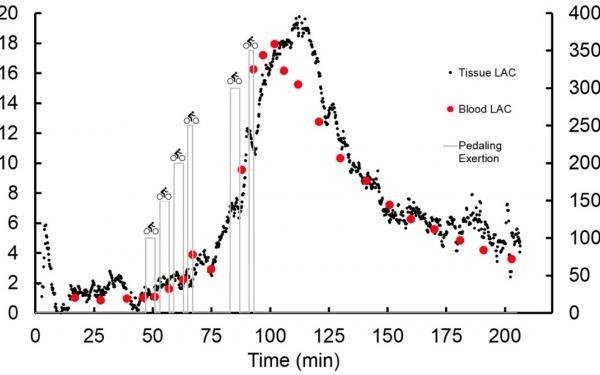
In future conflicts, with communication channels and evacuation routes contested, a lot more casualty care might happen right there on the battlefield.
by Mr. Ramin A. Khalili
Dr. Elliot Botvinick sits in his office on the campus of the University of California (UC), Irvine, holding a tiny device in the palm of his hand. It is smaller than a garage door opener, smaller than a standard business card even, and is so slight and inconspicuous that he might be able to stick one on a passing student without their noticing.
It also might be the future of battlefield medicine, according to the U.S. Army.
Minds like Botvinick’s may be exactly what’s needed to conquer approaching combat scenarios that experts predict will look starkly different than the current version, ones where the efficient use of targeted medical knowledge may be the single most important key to victory.
Botvinick’s handheld lactate monitor fits in perfectly then, as it features a wearable, subcutaneous microsensor designed to detect lactic acid levels, which rise in the body during episodes of critical illness and internal bleeding, both of which cause symptoms that aren’t always visible to the naked eye.
“We’re feeling pretty confident,” said Botvinick, a biomedical engineer. But while he is modestly optimistic, the Army expresses its faith in new medical technologies with a bullhorn.
To hasten the monitors’ delivery, the Army is looking to the Combat Casualty Care Research Program (CCCRP) of the U.S. Army Medical Research and Materiel Command (USAMRMC). “Our focus is squarely and specifically on the health and welfare of the warfighter,” said U.S. Air Force Col. Michael Davis, the newly installed CCCRP director.
In his role as an investigator with the CCCRP’s portfolio for Photonics and Light-Based Innovation for Severe Injury, Botvinick’s lactate monitor satisfies the Army’s desire for smaller, better technologies to operate in combat scenarios that will likely play out in denser, more urban areas, and in which prolonged field medical care will likely be the norm. Lactate is the chemical form of lactic acid that the body produces and uses.
“The vision [for the device] is something like a blister pack that you would peel open in the field and then a medic would just slap it on the body,” says Botvinick. “And in that simple act of slapping, an insertion needle would be guided just under the skin […] and then by pulling back on a sticker or tab, that needle would be removed and just a flexible fiber would remain.”
That tiny fiber would then interrogate the tissue around it, asking how much lactate exists in the area, according to Botvinick. From there, the assembled information would then be transmitted via Bluetooth technology to a wearable unit on the skin.
While measuring lactate is not currently the standard of care in the field (chiefly because current protocol requires blood samples to be drawn and then sent to a lab for study, a logistical nightmare in the field), Botvinick’s sensor measures lactate faster than the lactate level within the body can change, which makes it ideal for the fluidity of long-term transport situations, as well as transportation between levels of care. As such, a number of prototype devices are being prepared for shipment to the U.S. Army Institute of Surgical Research in San Antonio for animal model testing.
This is just one example from a research program rich with potential solutions.
BATTLEFIELD MEDICINE
Based in a small building on the southern edge of Fort Detrick, Maryland, the CCCRP is the only federal entity specifically tasked with developing the tools and knowledge required to aid injured warfighters on the battlefield. It comprises four portfolio management areas: Hemorrhage Control and Resuscitation; Neurotrauma and Traumatic Brain Injury (TBI); Prolonged Field Care and En Route Care; and the aforementioned photonics portfolio.
The Army is leaning on CCCRP to produce the next generation tools it will need to conquer and secure the rather bleak battlefield projected for the 2025-2040 timeframe. Specifically, experts predict the U.S. will likely encounter far more sophisticated enemies in the future than in previous conflicts, as well as enemy forces with the capabilities to degrade and inhibit U.S. access and superiority in the domains of air, maritime, cyberspace and emergency medical service.
That puts the execution of prolonged field care in the spotlight. A recent capability needs assessment commissioned by military leadership named prolonged field care as the No. 1 capability gap across the entire Army. Indeed, experts say future battlefields will require medical efforts to be more assertive at the point of injury as opposed to standard forward aid locations, a shift that also radically changes the concept of the “golden hour” standard of care, which relies on traditional medical transport to get service members treated within the first hour after injury.
Hi! I am a robot. I just upvoted you! I found similar content that readers might be interested in:
https://www.army.mil/article/197815/lighter_leaner_better_capabilities_speeding_combat_casualty_care_part_1
Downvoting a post can decrease pending rewards and make it less visible. Common reasons:
Submit
Congratulations @aulyars! You have completed some achievement on Steemit and have been rewarded with new badge(s) :
Click on any badge to view your own Board of Honor on SteemitBoard.
For more information about SteemitBoard, click here
If you no longer want to receive notifications, reply to this comment with the word
STOPDownvoting a post can decrease pending rewards and make it less visible. Common reasons:
Submit